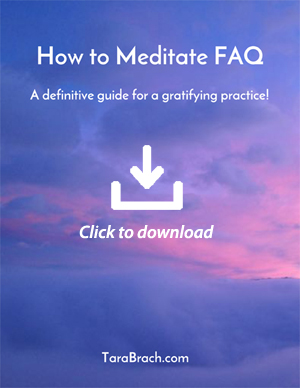What Are RAIN Partners?
RAIN – Recognize-Allow-Investigate-Nurture, the process of bringing mindfulness and compassion to difficult emotions, can be practiced with another person in a way that is deeply healing. RAIN partners agree to practice together on a regular basis—weekly, bi-weekly, monthly, or whatever arrangement works. A session takes 35-40 minutes and can be done in person, by phone or via the internet. Continuing as partners over time allows for a deepening of trust, safety and mutual support.
Resource: RAIN Partners Co-Meditation: Audio Guided Session (an audio guide for RAIN Partners)
Who Might Do This?
The prerequisites for being a RAIN partner are an established mindfulness practice (Insight Meditation/ Vipassana) and some experience working with the Recognize-Allow-Investigate-Nurture version of RAIN.
Your RAIN partner might be a friend, family member, colleague or someone you don’t know. Each partner should review these guidelines.
How Is This Different from Practicing RAIN on My Own?
Practicing RAIN with a partner can provide a safe, supportive relational space that keeps you focused and accountable to your own healing, deepens intimacy with another person, reveals that “it’s not so personal…others experience this too,” and serves awakening together. In other words, it’s juicy!
The Protocol
Audio-Guided Session
You and your partner might choose to use the audio-guided RAIN Partners Co-meditation for your sessions. If not, you will need to time yourself through the various segments, and refer to the below section on “the practice” until you become familiar with the meditation.
Preparation
Both partners reflect in advance on a “stuck place” where they are getting caught in difficult emotions. It might be something triggered in a relationship, at work, by a health issue or an addictive behavior, or events in our larger society. Each partner comes to the session with a particular situation in mind that activates the reactive pattern.
Note: It is important not to select situations that might set off trauma or emotions that are intense and overwhelming. Listen carefully to your own intuition as to what can be healthy to process and well contained in this partnering meditation.
You might find it helpful to bring water, tissues and journaling materials to the session. In addition, you might bring a bell, gong, or some other pleasant way of signaling the end of a timed portion of the meditation meditation (if you are not using the guided session).
When you convene with your partner, decide on who will be the first Speaker and who be the first Listener for the two periods of sharing in this session. Also decide on who will be responsible for keeping time if you are not using the guided-session. (Recommended: One person be the main time-keeper, but switch for the portions when they are the one sharing.)
It’s fine to lengthen the duration of any portion of the process when doing this on your own or with the guided session. But decide ahead if you are going to do this.
The Practice
1. Begin with a period of quiet meditation (3-10 minutes).
2. The R of RAIN, Recognizing: The first Speaker shares their situation and names the primary emotion(s) that become activated (3 min). The partner who is listening stays silent, offering an accepting, openhearted presence. Take a few moments for a silent pause, and then switch.
Note: It is very easy to get entranced in storytelling and lose track of time. Try to articulate just enough about your situation so that you can get in touch with the most challenging part about what is happening. Honoring the 3-minute limit will support you in this.
3. The A-I-N of RAIN: Practice the next steps of RAIN individually in silence (10 min).
A – Allowing: Bring your attention to whatever feels most difficult in what you have Recognized with the intention of fully “letting be.” Allowing is the willingness to pause and stay present with the life that is here, just as it is.
Allowing difficult emotions to be present requires gentleness and tenderness. Saying to yourself phrases such as “This too” or “Yes” or “I can hold this” can help. This is about opening to your experience, even when it’s painful.
I – Investigating: In RAIN, investigating is about inquiring into the felt sense of our experience rather than being a cognitive or analytic process. While your story and beliefs can be a portal to direct experience, keep returning your attention to your body, to the felt sense and sensations of wherever you feel most vulnerable. Bring an interested and kind attention to your experience.
Some of the following questions may be helpful in your investigation. Feel free to experiment with the sequence and content of your inquiry:
- What is the worst part of this? What most wants my attention?
- What is the most difficult /painful thing I am believing?
- What emotions does this bring up (fear, anger, grief?)
- Where do I feel these emotions inside?
- What is the felt sense of these emotions as sensations (i.e. clenched, raw, hot, sore, aching, empty, squeezed)?
- What do I notice when I assume the facial expression and body posture that best reflect these feelings and emotions?
These final questions are a transition to N-Nurturing. Stay connected with the vulnerable experience inside, and also sense that you are asking and listening from compassionate presence.
- If the most vulnerable hurting part of me could communicate, what would it express (words, feelings, images)?
- How does this part want me to be with it?
- What does this part most need (from me or from some larger source of love and wisdom)?
N – Nurturing: Take some moments to breathe consciously and adjust your posture in a way that helps you fully contact your most awake experience of heart and mind (sometimes perceived as your high or future self). Call on this wise and compassionate self or call on another being (such as a friend, family member, pet, teacher or a spiritual figure) whose wisdom and love you trust.
Offer inwardly the love, acceptance, forgiveness, compassion, or protection that the vulnerable part of you most needs. You might extend your care through words, touch (such as a hand on your heart) and/or imagery (such as seeing your inner child embraced or surrounded by light.)
As you complete Nurturing, you might sense if there is a message from your most awake heart/mind (future self) that will be helpful to remember.
(The timekeeper signals that 2 minutes remain for reflection on “After the RAIN.”)
After the RAIN (2 min.): This is the time to cease any “doing” and to take some moments to rest in the presence and heartspace that has emerged. Relax and let it fill you. Get familiar with it. If you are feeling some new or residual difficulty, offer this your acknowledgment and care. Before closing, pay attention to the quality of your presence and ask yourself:
- In these moments, what is the sense of my Being, of who I am?
- How has this shifted from when I began the meditation?
(The time-keeper signals when 2 minutes are complete. Before moving into the next sharing with your partner, feel free to take minute or so to stretch and/or drink some water.)
4. Reflective Practice with Partner: The first Speaker responds to the following questions, while the Listener attends silently. Switch. (3 min. each).
- What was challenging about this practice?
- What did I experience or learn about myself that I want to remember?
5. Unstructured Sharing: Maintaining a safe, respectful space for sharing (see below), take a few minutes to express anything else about your experience that feels important. This might include what it was like to listen to and share with another person.
What Helps Us Ensure the Creation of a Safe and Healing Space?
This partnering practice is based on a mutual commitment to creating a safe, conscious, and caring space for transformational work. All you share and all you hear in any session is to be held in strict confidence. Unless your partner specifically invites your feedback, please refrain from commenting on your partner’s sharing or offering any advice or counsel.
- Set up multiple dates, not just one. Whoever cancels a session is responsible for scheduling the next one.
- Determine with your partner if you will connect in person, by phone or online.
- Start on time. Remember that it’s easy to get lost catching up and you may not have the needed time for your co-meditation.
- Decide who will keep track of timing during the different portions of the practice. While it’s fine to extend the timing wherever you choose, agree on this in advance.
- Commit yourself to honoring the confidentiality of all that is shared.
- Don’t choose to work on issues that may trigger trauma or emotional intensity that you anticipate might be overwhelming.
- Discontinue the session if, due to physical or emotional discomfort, either partner feels the need to end.
- Remember that you are not doing therapy with each other: Stay away from guiding each other in the process, or in any way trying to “fix” by interrupting to comfort or advise.
- When your partner is sharing about their experience, remain silent and remind yourself you are offering the gift of an accepting presence. Consider yourself an interested and caring witness.
- If some judgment or other strong reactivity arises as your partner is sharing, regard that with mindfulness and self-compassion.
- Offer feedback or advice only if asked.
Resource: RAIN Partners Co-Meditation: Audio Guided Session (an audio guide for RAIN Partners)
RAIN Partners Protocol in .pdf for printing
More Resources on RAIN: Recognize, Allow, Investigate, Nurture here
Copyright © 2022 by Tara Brach, Ph.D.


